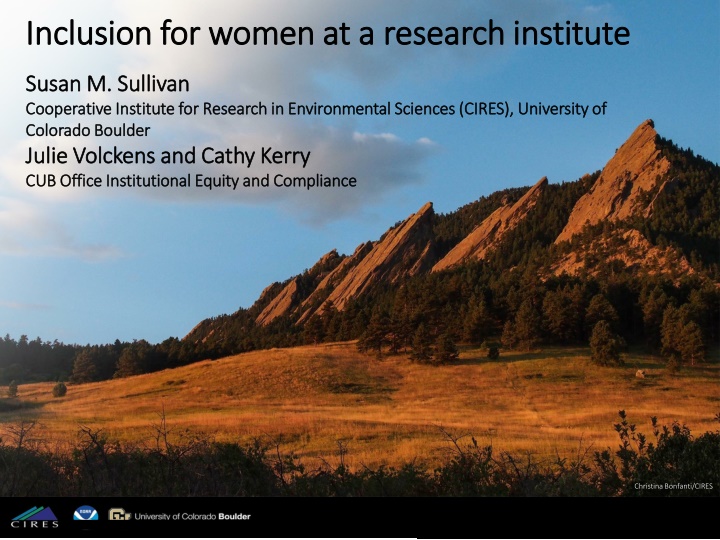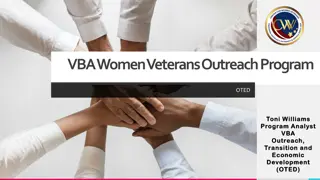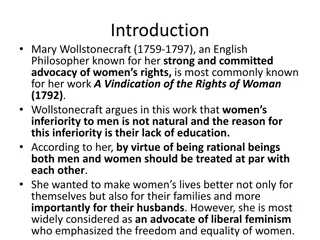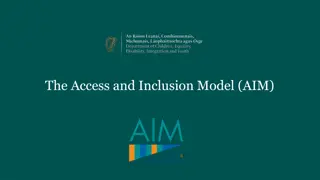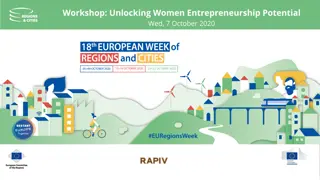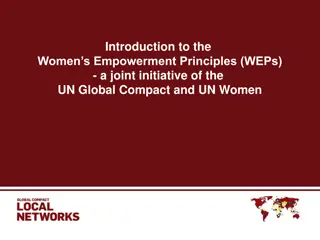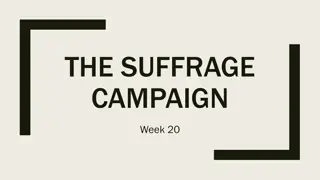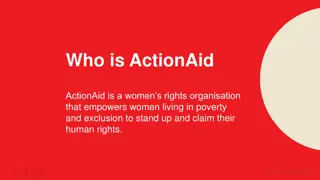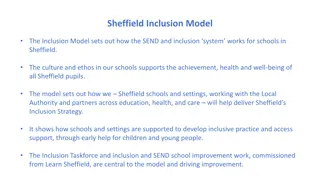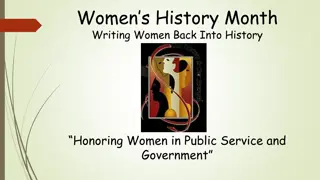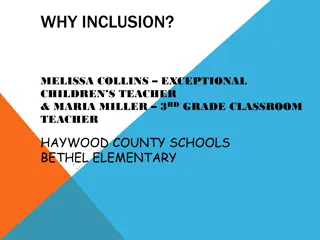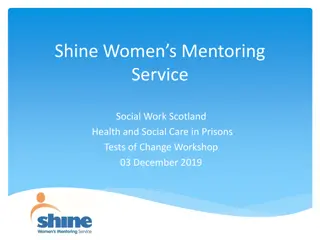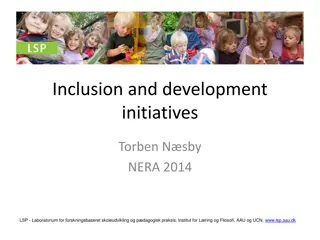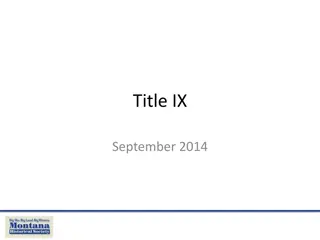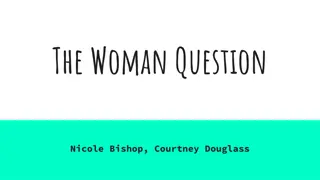Inclusion for Women at a Research Institute
Explore the workplace culture survey at a research institute focusing on inclusion for women, survey demographics, workplace environment statements, and experiences of negative treatment in the workplace. Gain insights into current culture, steps for improvement, and demographic representation to foster a more inclusive environment.
Download Presentation

Please find below an Image/Link to download the presentation.
The content on the website is provided AS IS for your information and personal use only. It may not be sold, licensed, or shared on other websites without obtaining consent from the author.If you encounter any issues during the download, it is possible that the publisher has removed the file from their server.
You are allowed to download the files provided on this website for personal or commercial use, subject to the condition that they are used lawfully. All files are the property of their respective owners.
The content on the website is provided AS IS for your information and personal use only. It may not be sold, licensed, or shared on other websites without obtaining consent from the author.
E N D
Presentation Transcript
Inclusion for women at a research institute Inclusion for women at a research institute Susan M. Sullivan Susan M. Sullivan Cooperative Institute for Research in Environmental Sciences (CIRES), University of Cooperative Institute for Research in Environmental Sciences (CIRES), University of Colorado Boulder Colorado Boulder Julie Volckens and Cathy Kerry Julie Volckens and Cathy Kerry CUB Office Institutional Equity and Compliance CUB Office Institutional Equity and Compliance Christina Bonfanti/CIRES
About the CIRES Workplace Culture Survey Purpose of the survey Understand our existing culture Determine what steps should be taken next Implement changes Survey partners CIRES Culture Survey Committee CU Institutional Research CU Office of Institutional Equity and Compliance Invited 726 employees (including CIRES@NOAA) Response rate 60% overall
Considerations for surveying Self-reports are not findings Close ended Third party confidential partners Safeguards Aggregate cell numbers (e.g. no report where fewer than 10 respondents) All hands debrief sessions Follow up focus groups
CIRES Workplace Culture Survey Survey Demographics Survey respondents reflect representation within CIRES 45% identified female 11% U.S. under- represented race/ethnicity groups 6% International 5% identified LGBTQIA Gender at CIRES Unknown or PNA 1.5% Male 58.1% Female 40.3% 0.0% 10.0% 20.0% 30.0% 40.0% 50.0% 60.0% 70.0%
CIRES Workplace Culture Survey Workplace Environment Statements 66 disagree/agree statements measured on a 6- point scale Belonging: I have a sense of community at CIRES Positive Support: Supervisors treat people fairly Perceived Prejudice: I have been singled out at work based on an aspect of my identity Trust and Respect: My comments/ideas are taken seriously by my colleagues
CIRES Workplace Culture Survey Experiences of negative Experiences of negative treatment in the context of work during the last context of work during the last 2 2 years Hostile treatment (incivility) Identity-based harassment Hostile treatment attributed to protected class identity Sexual harassment Discrimination Incivility is low-intensity behavior with ambiguous intent to harm the target, in violation of workplace norms for mutual respect. Andersson and Pearson, 1999, p. 457 treatment in the years
CIRES Workplace Culture Survey Consequences of Hostile Treatment % Agree/Strongly Agree Hostile Treatment Men Hostile Treatment Women No Hostile Treatment Men No Hostile Treatment Women Table 1. Workplace Environment CIRES1 Q1. I feel welcome at CIRES 71% 25% 90% 89% Q12. I feel welcome in my workgroup. 72% 44% 97% 97% Q27. Supervisors treat people fairly 57% 53% 96% 97% Q34. I trust my CIRES supervisor. 57% 63% 96% 100% Q38. My comments are taken seriously by my CIRES colleagues/coworkers 71% 38% 100% 100% Q40. My comments are taken seriously by my CIRES supervisor. 57% 62% 96% 100% Q51. My identity does not influence my supervisor s opinions about my abilities. 83% 44% 96% 94%
CIRES Workplace Culture Survey Discrimination (All CIRES) 23 individuals reported that they had experienced discrimination based on one or more aspects of their identity The most common identities mentioned were: Gender Age Race/ethnicity Pregnancy
CIRES Workplace Culture Survey Sexual Harassment (All CIRES) Experienced sexual harassment: 3% Women overall 7% / men overall <0.5% Note this is a lower level than reported elsewhere in geosciences Witnessed sexual harassment: 4% Range of harassing behaviors (8 types) Offensive remarks and stories or jokes Repeated invitations or advances Unwanted touch
CIRES Workplace Culture Survey Recommendations Increase sense of community and belonging Implement comprehensive onboarding (CU, CIRES, Workgroup) Address workplace incivility Reset workplace norms Build skills for conflict Reward collegiality Capacitate supervisors Skills for managing difficult behavior Support from leadership for addressing problem actors
Response to recommendations New onboarding program under development Mentoring program (under development) Supervisor training Increased employee training Bystander training, anti-harassment reporting Difficult conversations Values and policies alignment Performance assessment pilot
National Snow and Ice Data Center Performance Assessment Job Knowledge and Skills (50%) Manages NSIDC physical and human resources responsibly Respect (10%) Maintains effective working relations with others Is respectful of the needs of others Raises issues courteously and with consideration of others involved in them Demonstrates support in the center's commitment to diversity Communication (10%) Communicates in a manner that will be understood, is courteous, and effective in all mediums Service and Collaboration (15%) Focuses on the success of the team, project/award/contract and NSIDC over their own personal interest Leadership and Excellence (15%) Serves as a positive influence across the organization
Other next steps Campus wide culture survey NOAA-wide culture survey (including CIRES) CIRES D&I committee Develop/share evergreen resources
Questions? Susan Sullivan Susan.Sullivan@Colorado.edu Information interview or appointment https://calendly.com/susan-sullivan/information- interview http://ciresdiversity.colorado.edu/ 19
